Fokker D.VII (Fok) "Early"
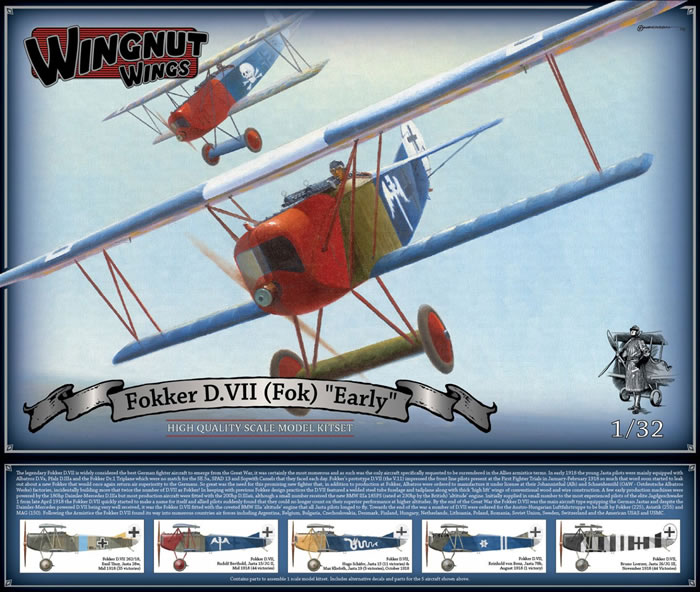
Wingnut Wings, 1/32 scale
S
u m m a r y |
| Catalogue Number: |
Wingnut Wings Kit No. 32067 - Fokker D.VII (Fok) "Early" |
| Scale: |
1/32 |
| Contents and Media: |
210 grey plastic parts including 19 parts exclusive to Fokker built aircraft; eight photo-etched metal detail parts; detailed instructions; markings for five aircraft. |
| Price: |
USD$99.00 plus shipping from Weta Workshop
£99.99 EU price (£83.32 Export Price) plus shipping available from Hannants |
| Review Type: |
FirstLook |
| Advantages: |
The Fokker D.VII is packed full of just about every detail you could wish for, with maybe only a little wiring needed here and there. This really is a very comprehensive kit, and one that builds perfectly. |
| Disadvantages: |
|
| Recommendation: |
Highly Recommended. |
Reviewed by
James Hatch

Revell's 1/32 scale Me 262 B-1/U1 Nightfighter will be available online from Squadron.com
Background
The Fokker D.VII was a German World War I fighter aircraft designed by Reinhold Platz of the Fokker-Flugzeugwerke. Germany produced around 3,300 D.VII aircraft in the second half of 1918. In service with the Luftstreitkräfte, the D.VII quickly proved itself to be a formidable aircraft. The Armistice ending the war specifically required Germany to surrender all D.VIIs to the Allies. Surviving aircraft saw continued widespread service with many other countries in the years after World War I. The D.VII entered squadron service with Jasta 10 in early May 1918. When the Fokker D.VII appeared on the Western Front in April 1918, Allied pilots at first underestimated the new fighter because of its squarish, ungainly appearance, but quickly revised their view. The D.VII was also noted for its high manoeuvrability and ability to climb at high angles of attack, its remarkably docile stall, and its reluctance to spin. It could literally "hang on its prop" without stalling for brief periods of time, spraying enemy aircraft from below with machine gun fire.
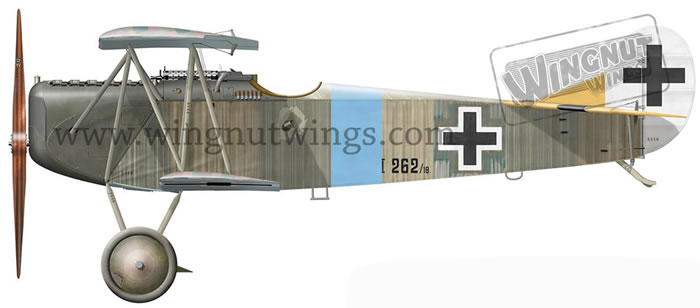
The D.VII also had problems. Several aircraft suffered rib failures and fabric shedding on the upper wing. Heat from the engine sometimes ignited phosphorus ammunition until cooling vents were installed in the engine cowling, and fuel tanks sometimes broke at the seams. Aircraft built by the Fokker factory at Schwerin were noted for their lower standard of workmanship and materials. Nevertheless, the D.VII proved to be a remarkably successful design, leading to the familiar aphorism that it could turn a mediocre pilot into a good one, and a good pilot into an ace. Manfred von Richthofen died days before the D.VII began to reach the Jagdstaffeln and never flew it in combat. Other pilots, including Erich Löwenhardt and Hermann Göring, quickly racked up victories and generally lauded the design. Aircraft availability was limited at first, but by July there were 407 in service. Larger numbers became available by August, when D.VIIs achieved 565 victories. The D.VII eventually equipped 46 Jagdstaffeln. When the war ended in November, 775 D.VII aircraft were in service. Armament was 2 × 7.92 mm (.312 in) LMG 08/15 "Spandau" machine guns, and the type was powered by either a Daimler-Mercedes D.IIIa/aü, or a BMW IIIa. Maximum speed was between 117mph and 124mph, dependent on powerplant.
Courtesy of Wikipedia.
For those that missed out on the four previous release versions of this kit, I suspect the release of Wingnut Wings’ Fokker D.VII (Fok) “Early” kit, will come as welcome news. Dare I say that I also suspect that for those that love this aircraft and bought the previous releases, this will also find a place in the stash. Well, the next time I expected to see the D.VII was in the fabled ‘Special Edition’ kits that have been mooted for some time, but I’m certainly not complaining about seeing another boxing of this beautiful kit. Wingnut Wings’ Fokker D.VII is already a proven kit in terms of engineering and fit, but seeing as the original kits were released 4 to 5 years ago, I’ll take a fresh look at the whole thing again, for the benefit of those who don’t know what this kit offers, and of course to highlight the differences between this and the original (Fok) release.
I personally think that the D.VII was one of the prettiest and most aesthetically pleasing aircraft of The Great War, and Steve Anderson’s silver-lined box art captures its lines beautifully. The sides of the box show the FIVE schemes offered in this release with Ronny Bar’s exceptional profile artistry. Inside the box, there are EIGHT medium grey sprues and a single clear sprue, all individually bagged to prevent damage to the fragile parts contained therein. You like decals? Good, as there are FOUR large sheets with this release. A single photo-etch fret is included too. Lastly, a glossy, full colour instruction manual completes the ensemble.
The Wingnut Wings release spiel is as thus:
-
Very simple rigging
-
4 high quality Cartograf decal sheets including fitted ‘Fokker streaky camouflage’, 4 & 5 colour lozenge and markings for 5 early production aircraft
-
210 high quality injection moulded plastic parts including 19 parts exclusive to Fokker built aircraft (plastic parts are the same as 32011 Fokker D.VII (Fok))
-
8 photo-etched metal detail parts
-
Optional cowlings, propellers, low & mid height gun mounts, cockpit coamings, windscreens, low & high exhausts
-
180hp & 200hp Daimler-Mercedes engines
-
Fine in scale rib tape detail
-
Full rigging diagrams
Sprue A
As is typical with many WNW releases, this sprue tends to hold many of the smaller components from around the airframe. With the exception of the tubular cockpit sidewalls, you will find almost every other cockpit part moulded here, as well as the fuel tank and gauge, engine firewall, empty ammo bin, gun mounting cross member frames and ammunition feed bin. The latter parts to be used with this release are the MID and LOW brackets and ammo feed bin. Please ensure you decide which aircraft you are building before you set out, as these small differences will mean the difference between accuracy and the unmentionable. Also, don’t confuse these similar parts, as there are ones also supplied for the HIGH mount, which aren’t applicable to this release.
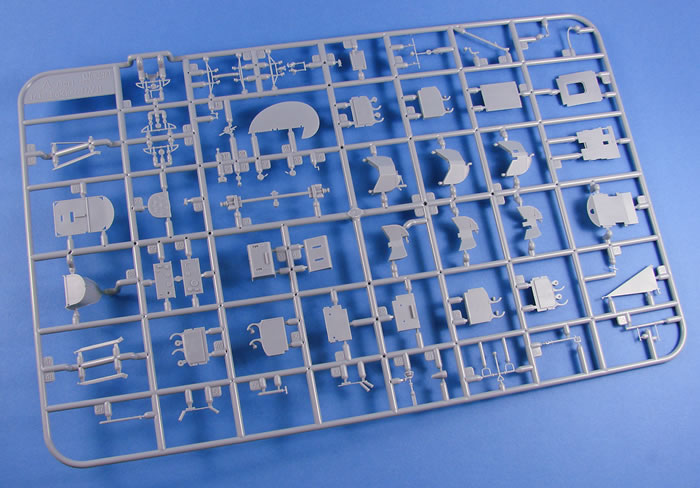
The cockpit itself is superbly appointed, with nicely detailed floor, pilot seat (with PE belts) and optional cushion, rear bulkhead with filigree canvas lacing detail, spark advance lever, fuel tank pressurising pump, control column and grip with throttle control, tachometer, and a compass/gimbal. Whilst two instrument boards are included, only one of the parts is suitable for the early D.VII. This is to be fitted with a Bosch magneto, and decals are supplied for the instruments themselves and the various signage on the panel. An optional altimeter is included with the only proviso that you don’t fit it on the right hand side when building option A, with the streaky Fokker finish.
Other parts on this sprue include the inner and outer radiator panels (two other sets of parts included, but not for use here), lower engine cowl (common to all versions on this kit), empty belt chutes, optional Oigee gun sight, undercarriage struts and spreader bar (with moulded bungee detail), rudder, tailskid etc.
Sprue B
Here you will find the fuselage halves, moulded with beautifully subtle external details such as the control cable grommets. Externally, there isn’t much else to see, which is the nature of the aircraft. Due to the various permutations of engine cowl etc. the forward fuselage ends just before the first cowl plate (or in this case, the fabric panels that were a feature of the early machines).
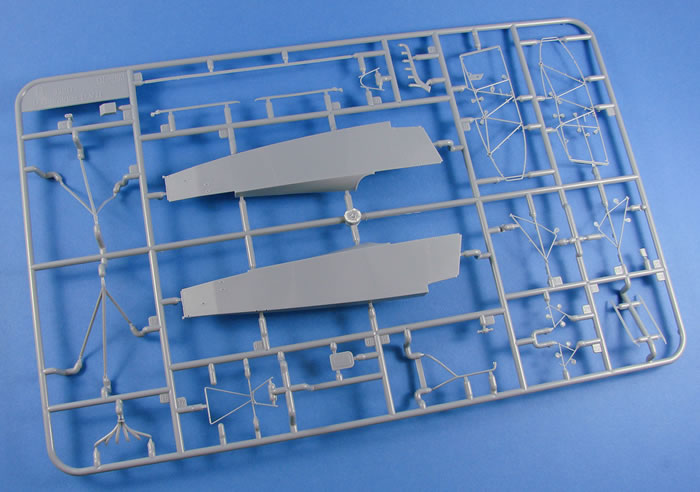
This sprue contains many fragile parts, such as the sidewalls cabane struts and engine bay frames. The very nature of these parts means that WNW has moulded small tags onto them which are used for mould pin ejection. This is a neat idea which means that the part itself isn’t impinged upon with ejector pin marks. Of course, you’ll need to snip all of these away and clean up the gate point, but the trade-off is a beautifully fine moulding. With the sidewalls, you will need to snip away the innermost forward stanchion. Some frames on other manufacturer-built airframes were shorter, and the kit parts cater to all versions. The cockpit frames are very fine and very detailed. As with many parts in this kit, I advise that you use a fine razor saw to remove them so that your cutters don’t cause distortion when you clip through the plastic.
Other parts here include the lower cowling sump panel, radiator piping and two exhaust options. The only part not pertinent to this release is the oil tank.
Sprue C
The clear sprue.
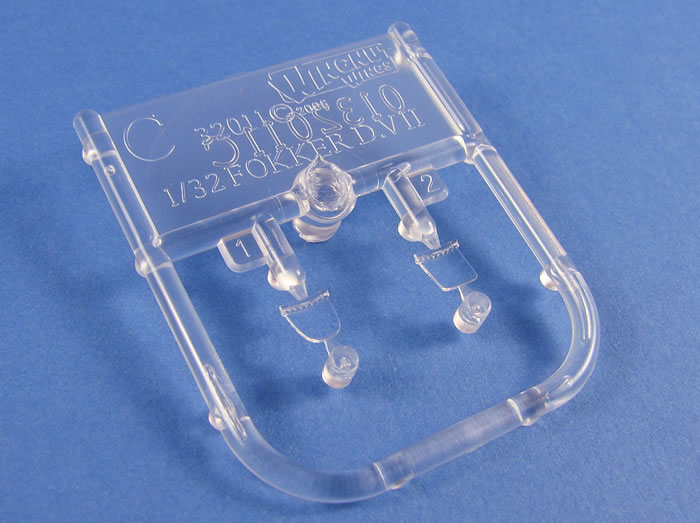
Not a lot here to talk about except to tell you that it offers two windscreen options with nicely defined frame lines, and the parts are perfectly clear.
Sprue D
Of course, you’ll find here the parts for which there are multiples of the same, such as the wheels, separate wheel hubs, axle captive nuts, outer inter-plane struts, ailerons, machine guns, control horns etc. Two Spandau options are given here. These are for the standard plastic guns, and one for a jacketless MG. Onto this will fit a rolled PE jacket for more authenticity. A plastic former is also included for you to roll your flat brass part around.
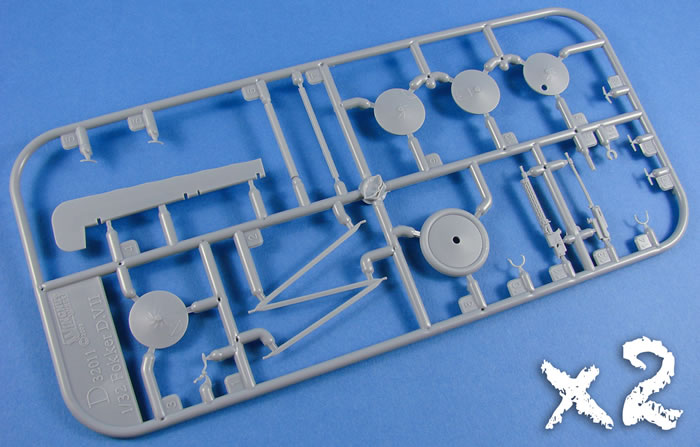
The wheels are quite nice too. These are moulded with separate outer hubs, and within the main wheel hub, a little spoke detail is moulded, along with the nipple to inflate the tyre. Alas, this detail won’t be seen for this version of the D.VII, as the hubs have a fabric patch and not the actual opening. Aileron detail is negligible, as there was barely any rib detail to be seen on the real aircraft. Note that the ailerons aren’t handed either, meaning they are interchangeable. No worries about gluing the port to starboard etc.
Sprue E
‘E’ is for engine. In this case, the early D.VII flew with either a Daimler-Mercedes 180 D.IIIa or 200hp D.IIIaü. There are a good number of parts not for use here, such as the Heine and Wolf propellers, plus a sump, rocker covers etc. Still, there are enough parts here to satisfy the ardent detail fanatic.
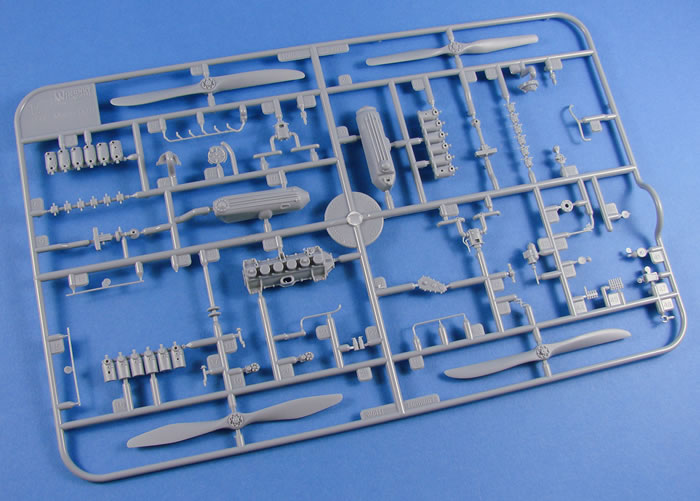
The engine itself comprises around 25 parts, with options of course for the water-cooled intake manifold and plumbing, plus the flywheel. If you aren’t fitting the latter, you can add a generator. I would say check your references, but I don’t think that old cliché is useful when you’re dealing with an aircraft from around one century ago. An air pump is an option if you’re not fitting the water-cooled parts.
Sprue F
Only two parts here; the full span upper and lower wing panels for the upper wing. These are moulded sans ailerons, so you may pose these dynamically, should you wish.
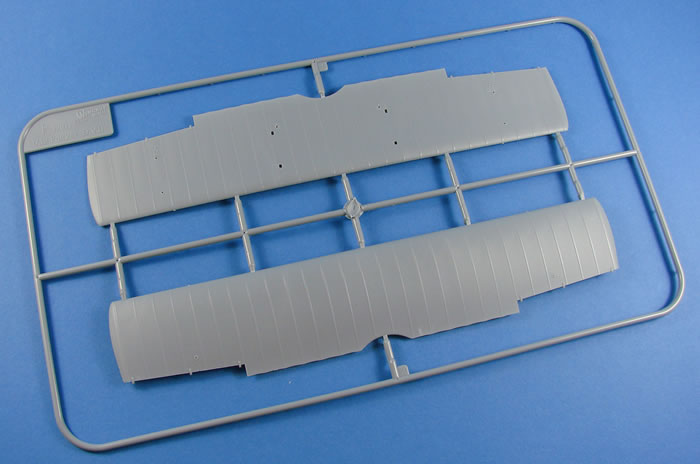
Surface detail really is excellent, with a highly realistic doped fabric appearance and rib caps/tape detail. Leading edges have finely moulded wing stacking pads, and strut locating points are clean. It would be worthwhile just drilling out the holes further for the control cable points, but remember, that the D.VII itself doesn’t have much in terms of rigging, which will doubtless please a lot of modellers. Wing trailing edges are very thin too, with light being visible if you hold them up to a lamp. This area also has a subtle scalloped finish, as would be the result of the doped fabric pulling on the wire trailing edge of the real aircraft.
As the D.VII’s upper wing is relatively thick, WNW has included some locating points within the wing, that after gluing, should provide some nice reinforcement and prevent the wing from being squeezed and cracking any glued joint.
Sprue H
This is another sprue that’s common to all previous D.VII kit releases, and it contains a full-span lower wing panel with upper port and starboard panels, two upper cockpit deck options, the single-piece stabiliser and elevator. Wing and tail-plane detail is again superb and restrained, with positive strut positions where appropriate, and nice elevator hinge detail on the stabiliser.
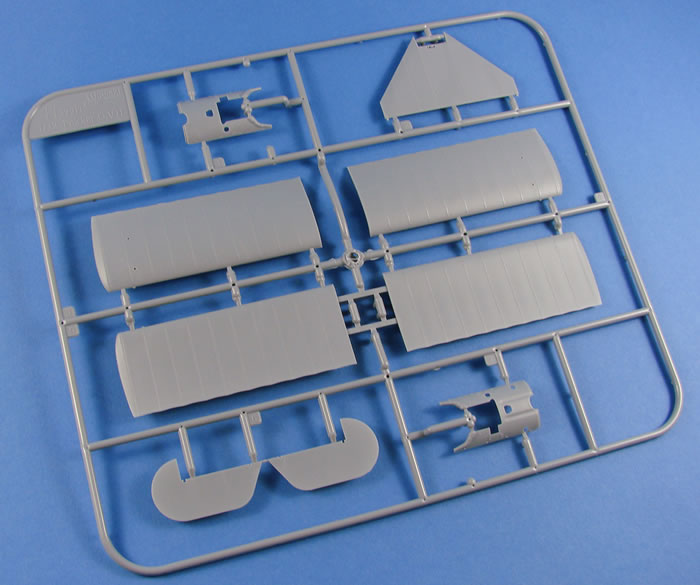
The elevator itself is, like the aileron in that detail is limited. Again, this is correct. You will also find two upper fuselage/cockpit decks here.
Sprue I
This is the last grey sprue and it contains the various permutations of cowl parts including both side and upper panels. This contains two different sets of side panels, a single nose cowl and three options for upper engine cowls. Other parts are included for these, but they aren’t applicable to this specific release. One set of side cowls will need to be modified if you are using the louvered option. This involves cutting out a hole for the low exhaust stack, and the removal of four forward louvres. Parts for the undercarriage wing are found here too, and this version doesn’t require you to cut and shorted them.
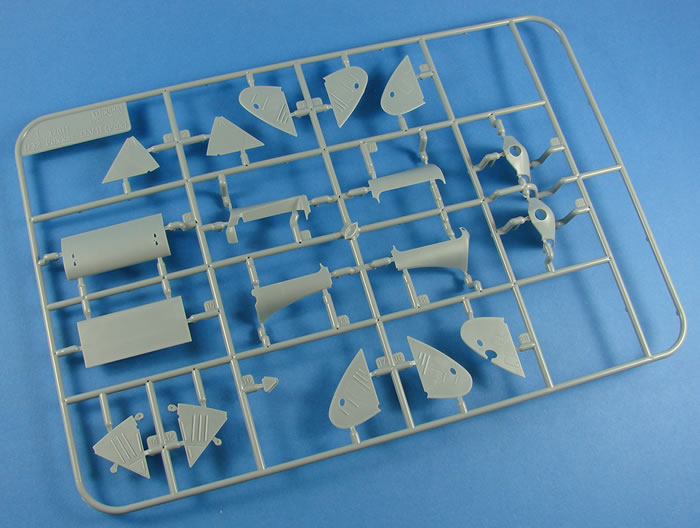
With regards to the plastic, there really isn’t anything to fault anywhere on this kit. Seam lines are negligible, flash is pretty much non-existent, and ejector pin marks won’t hinder you. No sinkage etc. can be found anywhere. This model will be a joy to build from that perspective.
Photo Etch
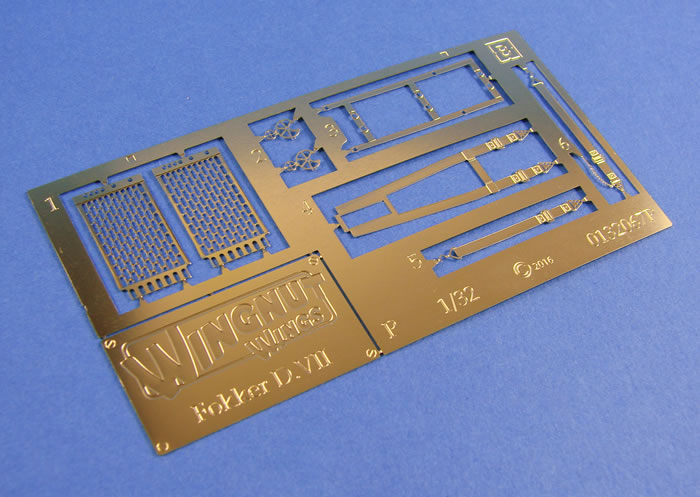
The parts on this look identical to the previous D.VII releases, but the layout is different. This may be to incorporate the nameplate that is now a part of WNW releases. Either way, these parts are interchangeable with those of the previous releases. Here you will find the Spandau MG jackets, end caps and reticules, seatbelts and the MG flashguards. Quality is excellent, with parts being held in situ by small tags that will be easy to cut through.
Decals
As previously stated, there are FOUR large decal sheets here, printed by Cartograf. It’s great to see WNW add a Fokker streaking decal set when only one of the schemes actually calls for it all (with the exception a small fuselage piece on one other scheme.
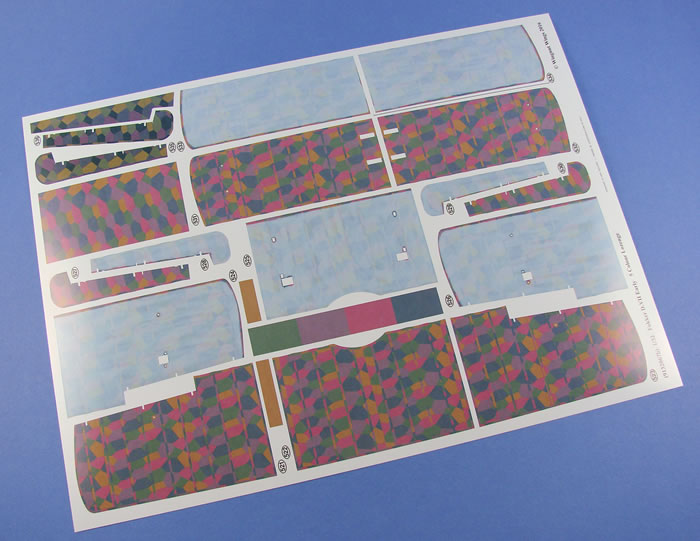
This is quite strange when you consider that they don’t include the black and white stripy decal for Bruno Loerzer’s machine. It’s very easy to mask off though, but they have included full side pattern decals in other releases. One sheet contains a full suite of streaking decal (with some sections not for use), and wheel hub outer edge decals. One sheet contains a set of 4-colour upper and lower wing lozenge, and another has 5-colour lozenge, but this time, the lower lozenge represents the coat of light blue paint that was applied.
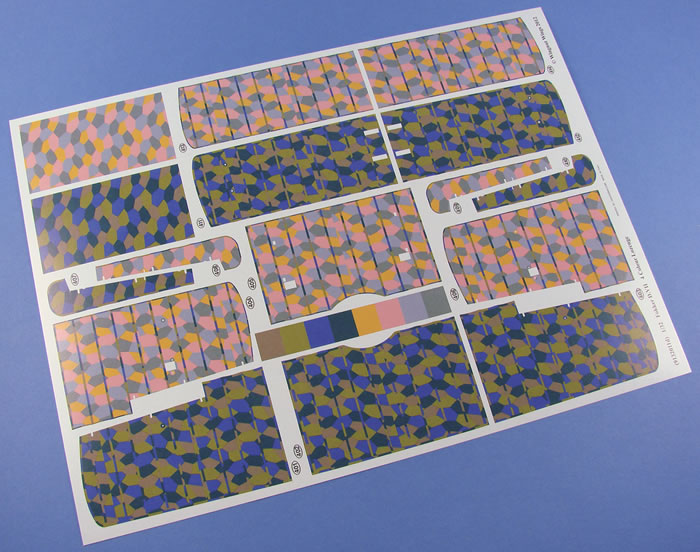
In a twist, the first scheme that employs the streaking decal, also includes the lighter lower wing lozenge applied to the UPPER surfaces! I can guarantee that if you have this finished model on your club stand, someone will tell you that you did it wrong! Probably my favourite scheme of them all, and they are all worth building.
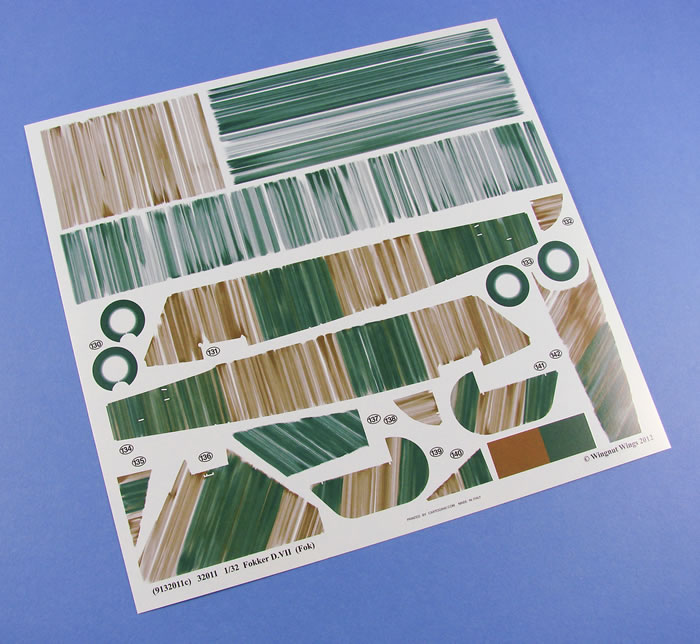
The remaining decal sheet contains all of the national markings, motifs, as well as some tail-plane lozenge and sections of lighter lozenge that fit within the cockpit area (for the non-streaky fuselages). More lozenge is included to wrap around the upper cockpit frame and some pieces for the rear bulkhead.
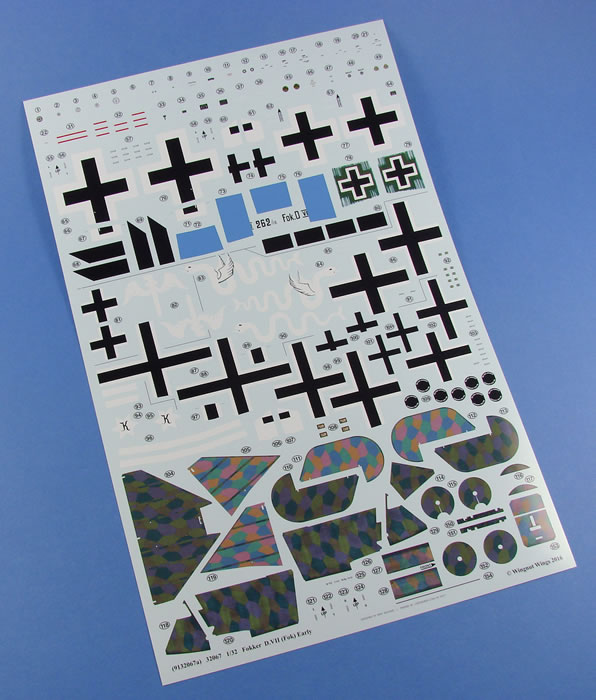
Cockpit instrument and signage decals are included, as are a full set of stencils. All decals are glossily printed, thin and contain minimum carrier film. Colours are solid and authentic, and printing is in perfect register. The FIVE (actually six!) schemes are:
-
Fokker D.VII, 262/18, Emil Thuy, Jasta 28w, mid-1918 (35 victories)
-
Fokker D.VII, Rudolf Berthold, Jasta 15/JG2, mid-1918 (44 victories)
-
Fokker D.VII, Max Kliefoth, Jasta 19, October 1918 (3 victories) (SCHEME C1)
-
Fokker D.VII, Hugo Schäfer, Jasta 19, October 1918 (SCHEME C2)
-
Fokker D.VII, Reinhold von Benz, Jasta 78b, August 1918 (1 victory)
-
Fokker D.VII, Bruno Loerzer, Jasta 26/JGIII, November 1918 (44 victories)
Schemes C1 and C2 are very similar with the exception of the nose, undercarriage and cabane strut colours, hence the inclusion of both options.
Instruction Manual
No one does these quite like WNW. This glossy A4 publication contains 26 pages, printed in full colour and begins with a parts map and colour references which are used throughout the construction process. The illustrations are in drawing style, and generally coloured in greyscale, but blue is used to highlight new parts addition, and yellow where PE parts are to be added.
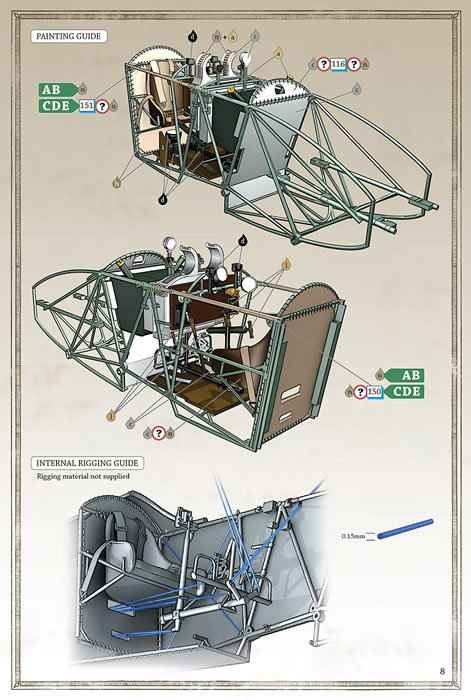
Full colour illustration is also supplied for key areas, such as the cockpit and engine, giving the modeller an immediate idea about how things should look once painted, despite the references being given throughout construction. Contemporary and period photographs are included, and the last pages are taken over by the excellent colour profile work of Ronny Bar, with some historical and scheme notation. Decal placement is easy to follow, as is the colour guide.
I'm more than sure that this new release will be more than welcome by WNW enthusiasts, and not least those that missed out on the previous four incarnations of this kit.
The Fokker D.VII is packed full of just about every detail you could wish for, with maybe only a little wiring needed here and there. This really is a very comprehensive kit, and one that builds perfectly. Again, it's great to see a number of machine-specific options included here, and a total of four large decal sheets to create another series of beautiful examples of this important aircraft type.
Price-wise, I don't think this can be beat. Building this model really is an adventure, and a thoroughly enjoyable one at that.
Now, I wonder if we'll see any WNW separate decal sets for this release!
Highly Recommended.
Thanks to Wingnut Wings for the sample
Review Text and Images Copyright © 2017 by James Hatch
Page Created 15 May, 2017
Last updated
15 May, 2017
Back to HyperScale Main Page
Back to Reviews Page |
